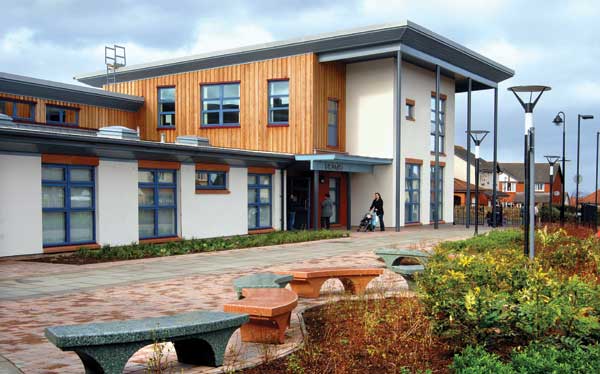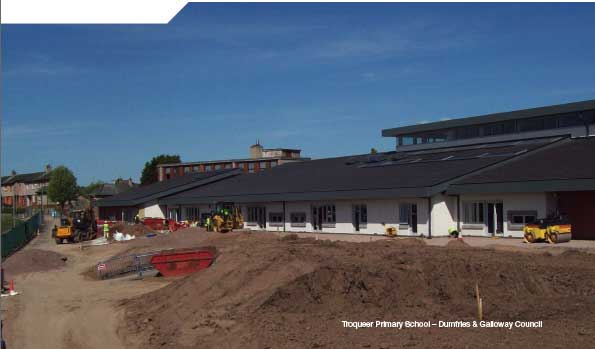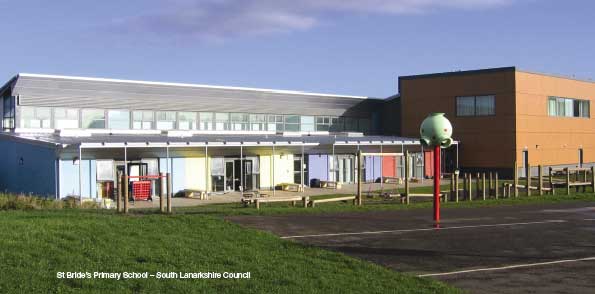Building better schools: investing in Scotland's future
The school estate strategy is relevant to all parts of the learning environment: the buildings and spaces, the grounds, the fixtures, facilities and furniture.
6 NEXT STEPS

The School Estate Strategy represents the first step in a long-term programme of joint work by Scottish Government and local government on the school estate. The next steps will be to develop - as recommended by Audit Scotland - a Financial Strategy and Implementation Plan by 2010 for delivering the Strategy. The three parts - the Strategy itself, the Financial Strategy and the Implementation Plan - will constitute a joint strategic approach to and plan for the continuing improvement of Scotland's school estate. As the Strategy itself sets out the agreed policy objectives and framework within which local activity and planning will take place, the overall Implementation Plan will represent a national summation of 32 local strategies and plans for action. Equally, the Financial Strategy will be about local authorities matching the Scottish Government's commitment through preparing long-term plans in the context of local needs, priorities and resources so that the principles of this School Estate Strategy can be delivered in full.

Resources and funding
Appropriate resources and funding will be fundamental to achieving the aspirations and objectives set out in the Strategy. Scottish Government makes capital and revenue resources available to authorities through the local government settlement. During the current Parliamentary period, Government sign off of further revenue schools projects (including NPD and PPP) and the inclusion of record levels of capital funding in the local government settlement for 2008-2011 are already supporting a programme of local authority investment in the school estate in excess of £2 billion. In addition, authorities will continue to invest, year on year, in their school estates, utilising the capital funding provided in future local government settlements and other funding sources available to them such as capital receipts and developer contributions.
In June 2009 Government announced an additional £800 million of funding towards a £1.25 billion school building programme that will see the replacement of around another 55 schools, benefitting around 35,000 or 5% of Scotland's pupils. This represents the next phase of the school investment programme and the next steps towards achieving the condition target set out on page 34.
Local government in turn applies additional resources from various other potential sources to the overall amounts which are deployed locally for investment in the school estate. The scale of the estate and of the task ahead - and the shared commitment which this Strategy represents - means that investment in schools will always need to feature as a major consideration in successive government spending reviews and local authority budget setting processes and capital plans.
The Audit Scotland report indicated that it would require at least another £5 billion of investment in order to overtake the legacy of underinvestment and attain a state of equilibrium where the rate of improvement of the school estate matches the rate of deterioration. Achieving this will involve a genuine sharing of responsibility across local and national government for the funding of improvements and the phasing of progress depending on the availability of resources and both national and local prioritisation. Moreover, amid a tightening environment for the public finances, it will require commitment on all sides to prioritise resources and maximise value for money from investment in the school estate. This approach reflects both the current economic realities and the principles set out in the Concordat. The Strategy must above all serve to ensure that deployment of resources and funding is best targeted.
The Financial Strategy will focus on identifying the scale and sources of the funds required to deliver the Strategy. It will look at timescales, procurement options, and the changing balance of expenditure as between new build, refurbishment, repair and maintenance we approach that state of equilibrium. Of course, by no means all schools which are categorised as being in 'poor' condition (category C) require immediate replacement. In most cases their removal from condition category C will be achievable through appropriate repair, refurbishment or modification. The Financial Strategy (and the Implementation Plan) will need to recognise the range of appropriate works, different degrees of urgency and different levels of investment requirement to address the remedial action required to schools in condition categories C and D. The Scottish Futures Trust will also play a significant role in the development and implementation of the Financial Strategy.
Experience suggests that the pace of forward progress will depend on a number of factors, not all of them financial. For instance, capacity constraints in the construction industry or financial sector and the capacity, skills and expertise of local authorities to plan, manage and deliver large scale change and improvement will all bear on the rate of implementation of this Strategy. Moreover, inadequate spend on subsequent maintenance can lead to inflated repair costs later on and a truncated lifespan. Constraints and factors such as these highlight the increasing need to share and improve best practice and experience, and develop expertise and capacity at both national and local level. The Scottish Futures Trust again play a role here.
There is also both a need for, and a potential benefit from, looking at the school estate not in isolation from, but alongside and in context of other public sector assets. Considering the schools dimension within the wider strategic processes of local authority asset management planning - entirely appropriate given the range of public services delivered through schools - should serve to improve efficiencies in planning, investment and management across the public sector, and to open up new possibilities for the way funding packages for improvements are put together.
Measuring Progress
When the focus of attention is a capital intensive fixed asset with a long lifespan, where the lead-times for planning and building new schools are long, success in turning aspirations into reality will only really be demonstrated or measured over a timespan of years, even decades. We should nevertheless strive to improve the clarity of the early indicators which will signal over the next few years whether the first steps that we take are in the right direction. The School Estate Strategy itself will begin to make a difference immediately by prompting people to think in new ways about the planning and management of the school estate.
Local and Scottish Government have worked together in recent years to develop the information base of Core Facts data on the school estate. That was embarked upon in order to improve the national picture and understanding of the state of the school estate and inform policy and decision-making. Scottish Government has also supported the development of local School Estate Management Plans as a means of assisting individual authorities to plan, develop and manage their school estates in a strategic and better-informed way.
This Strategy builds on that developing information base, looking ahead to what local and Scottish Government want to secure and achieve in return for the huge investment we make in the school estate. It will not be achieved overnight but the Strategy identifies where resources should be directed - to where there is greatest need and where we can achieve maximum impact and benefit.
Success will be a school estate which contributes to the delivery of national and local objectives and policies and positives outcomes for the people of Scotland. That will be hard to measure directly because the causal effect of good school buildings and facilities for instance on attainment and achievement are difficult, if not impossible, to separate out from all the other input factors such as quality of teaching, parental support and so on. That said, improvements to the school estate will feed through into and be detected across the suite of national and local indicators set out in the Concordat, the National Performance Framework 29 and authorities' Single Outcome Agreements.
The well-established Core Facts dataset is being continually refined and expanded to ensure greater robustness and consistency across the board. At present the best developed measure is of the condition of schools. Work though has been underway for some time to develop a new methodology for systematically measuring the much more challenging issue of a school's suitability or fitness for the purpose of supporting modern education. Further work is already planned to look at indicators of capacity and occupancy that will shed light on what constitutes maintaining a 'sufficiency' of school accommodation in the face of ever changing patterns of demand. Throughout, the emphasis will increasingly be on looking not just at ways of measuring the state of schools but also on ways of attempting to measure impact and advantage for those who benefit from the improvements - the pupils, staff and other school users.
Aside from further development of the Core Facts data signalled above, the forward plan of work will involve a range of other initiatives and developments all intended to help realise the Strategy's aspirations. The set of guiding principles and objectives sets the parameters for and will provide a stimulus to future work at both local and national level. This will be progressed by way of a series of partnerships, through joint and commissioned work, publications, conferences, seminars, workshops, networking and the development of guidance and better ways of sharing good practice.
Looking ahead
This Strategy will have an impact for a long time to come. In order to deliver the improvements we want to see in outcomes there is need to plan for the short, medium and long term. Set out below are factors which have to be considered over different timescales in planning future school investment.
We recognise that educational and demographic changes will have a major bearing on the shape and nature of the future school estate. The pace of change and evolution is determined by a number of factors - some within the influence of local and Scottish Government - and some outwith our control. Indeed a Strategy which is having an impact will quicken the pace of change. Therefore, we fully expect the Strategy to be reviewed and refreshed in a few years, in order to take account of changing policies, resource availability, progress achieved and a new perspective from a new point in time.
For now, we need to consider the view from the point we have reached in the current programme of school estate investment, and in the widest possible context. This provides our present sense of perspective, though that can be distorted if the issue of improving the school estate is considered over too short a timeframe. Parts of the school estate include Victorian buildings dating back 150 years, some of which may (with appropriate adaptations) well serve communities for years to come. Looking ahead we hope that well designed and maintained new schools will last for at least 60 and perhaps a hundred or more years. Therefore we are dealing with buildings and facilities spanning more than 250 years in total. Decisions taken now on procurement and on maintenance will resonate for decades to come.
We need to resist the temptation that this Strategy looks ahead over a finite or specified period of time. Planning for the future school estate needs to take a range of future timescales into account. By way of illustration, the Climate Change (Scotland) Act 2009 sets a target for a 80% reduction in greenhouse gas emissions by the year 2050. Funding arrangements involving revenue finance or indeed borrowing to repay capital can often extend over a timescale of up to 30 years - which will therefore extend to around the year 2040. The Audit Scotland Report suggests that it may take until sometime into the 2020s to improve the condition of all the schools which are still in poor or bad condition and to reach that 'state of equilibrium'. In terms of public investment plans, anything significantly beyond 5 years ahead - ie beyond the middle of the next decade - is of necessity more in the nature of a 'statement of intent' than a detailed plan because neither local nor Scottish Government can project resource availability and therefore expenditure levels much beyond the 3-year cycle of Spending Reviews.
This strategy represents the start of a significant new phase in the journey to deliver a modern, fit for purpose school estate. The emphasis needs to be more on the start of that new phase than on the end of the journey. The Strategy must speak most clearly to those taking decisions now about the first new steps down the road. No one administration, national or local, can contemplate or be responsible for 'completing the task' of improving the school estate. It is, by its very nature, a continuous process. Each successive administration, national and local, working in partnership, must play its part in the endeavour, ensuring that the school estate fulfils its potential to improve our society, economy and the lives of everyone in Scotland.

There is a problem
Thanks for your feedback